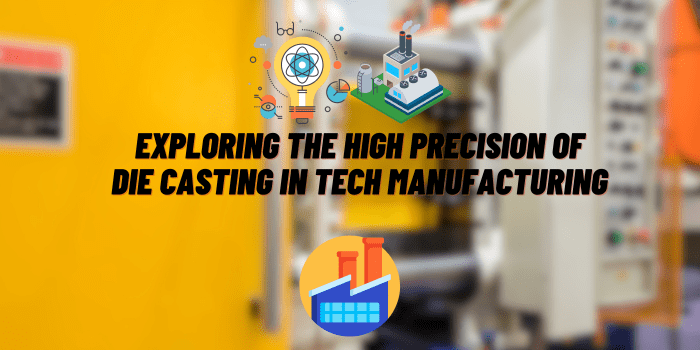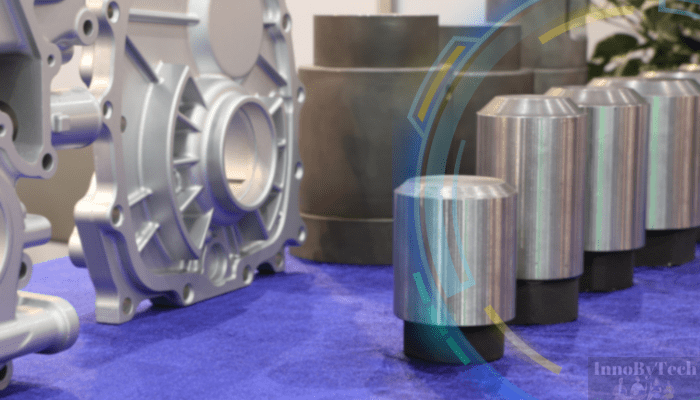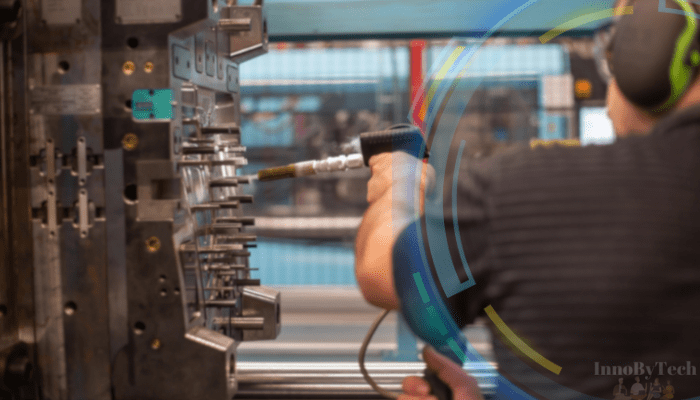Exploring the High Precision of Die Casting in Tech Manufacturing
In the fast-paced world of tech manufacturing, precision is everything. The demand for smaller, faster, and more intricate components necessitates manufacturing processes that uphold the highest standards of precision. One such process is die casting.
In this blog post, we are going to examine its role in achieving high precision in tech manufacturing and explore its importance in creating the cutting-edge products we use every day.
What is Die Casting?

Die casting is a manufacturing process that involves injecting molten metal into a mold cavity, or die, under high pressure. This results in the creation of intricate shapes, detailed designs, and smooth surfaces. It finds its application primarily in the production of non-ferrous alloy components, which are widely used in various industries, including tech.
It was in the early 20th century that die casting gained substantial popularity in tech manufacturing. With advancements in technology and manufacturing techniques, die casting evolved from a rudimentary process to a sophisticated method that meets the demanding requirements of the tech industry.
Die casting offers several advantages that make it a preferred choice for tech manufacturers. Firstly, it allows for the production of complex shapes with tight tolerances. The precision of this process eliminates the need for additional machining, thus reducing overall production costs. Secondly, it enables rapid production cycles and high-volume output, meeting the time-sensitive demands of the industry.
Additionally, die casting produces components with excellent mechanical properties and exceptional surface finishes, making it suitable for a wide range of applications. Lastly, it proves to be a cost-effective process in the long run, thanks to its high production efficiency and minimal scrap waste.
The Role of Precision in Tech Manufacturing
As already mentioned, precision is of utmost importance in tech products. Even the slightest deviation during the manufacturing process can lead to design flaws or functional failures. The intricate nature of tech components requires an exceptional level of accuracy, ensuring optimal performance, reliability, and durability.
Countless tech products owe their success to precision manufacturing. For example, pacemakers require highly precise components to ensure correct functionality without compromising the patient’s well-being. Smartphones, with their multitude of components, require precise alignment to provide an exceptional user experience. Additionally, the aerospace industry relies heavily on precision manufacturing, ensuring that aircraft components can withstand the demanding conditions of flight.
The Process of Die Casting

This method involves several key steps to achieve high precision. First, the mold cavity is prepared with utmost accuracy, ensuring the correct shape and dimensions of the final product. The molten metal is then injected into the mold under high pressure, filling the cavity and creating the desired shape. Once solidified, the part is ejected from the mold, and the cycle begins again.
It can be categorized into different techniques, namely hot chamber die casting and cold chamber die casting. In hot chamber die casting, the molten metal is held in a shot sleeve that is immersed in a molten metal reservoir. This technique is suitable for metals with low melting points, such as zinc. Cold chamber die casting, on the other hand, involves manually ladling the molten metal into a shot sleeve separate from the mold. This technique is suitable for metals such as aluminum and copper alloys.
The die casting process requires specialized tools and equipment to achieve precision. The mold, or die, is carefully constructed to exact specifications, allowing for the creation of intricate shapes and details. High-quality metals and alloys, such as aluminum, zinc, and magnesium, are used for their excellent casting properties and mechanical strength.
Achieving High Precision
The design phase is crucial in achieving high precision in the die casting. Components must be designed with the manufacturing process in mind, ensuring that all features can be accurately replicated in the final product. Factors such as draft angles, wall thickness, and the proper placement of features all contribute to achieving this. The development of high-quality alloys and surface treatments ensures the production of components with superior precision and durability.
Quality control is also very important. Various inspection methods, such as coordinate measuring machines (CMMs) and optical scanners, are used to verify the dimensional accuracy of the components. In-process monitoring and rigorous testing protocols help identify any deviations from the desired specifications, ensuring that only high-precision components move forward in the production process.
Applications in Tech Manufacturing

Automotive industry: Die casting plays a vital role in the automotive industry, where high-precision components are needed for engines, transmissions, and various structural parts. The ability to produce complex shapes and achieve tight tolerances makes it a preferred method for manufacturing critical automotive components.
Electronics and consumer goods: In the electronics and consumer goods sectors, it is used to manufacture a wide range of components. From smartphone frames and laptop hinges to audio speaker enclosures, die casting ensures the precise replication of intricate designs and the production of lightweight and durable parts.
Aerospace and defense sectors: The aerospace and defense sectors rely on this process for the production of critical components used in aircraft and defense systems. The precision of die casting ensures the structural integrity and reliability necessary for these demanding applications.
Successful Implementations in Manufacturing
One notable example of successful die casting implementation is the production of lightweight and high-strength aluminum components for electric vehicles. Parts such as battery housings and structural components, contribute to the overall efficiency and performance.
Precision also played a crucial role in addressing the challenges faced by a tech manufacturer producing miniature electronic components for medical devices. It allowed for the production of tiny, intricate parts, ensuring accurate functionality and reliable performance in critical medical fields.
Future Trends

The future of die casting and precision manufacturing promises exciting advancements. Increasing automation through robotics and artificial intelligence (AI) is set to enhance the efficiency and precision of the die casting process. Additionally, the development of new alloys and composite materials will open up new possibilities for achieving even higher precision and superior mechanical properties.
Precision manufacturing will continue to be at the forefront of tech industry advancements. As products become smaller and more intricate, the demand for high-precision components will only grow. The integration of precision manufacturing with other emerging technologies, such as additive manufacturing and advanced robotics, will further revolutionize the industry, leading to the creation of innovative products that were once unimaginable.
In Conclusion
In tech manufacturing, precision is the key to success. Die casting is a process that unleashes the power of precision, allowing for the production of complex, high-quality components that drive the tech industry forward. From automotive to aerospace, it finds its place in crucial technology sectors.
As we look ahead, the future of precision manufacturing is promising, with advancements in technology and materials set to take high precision to new heights. We can expect to witness remarkable innovations that continue to redefine the boundaries of what is possible.






